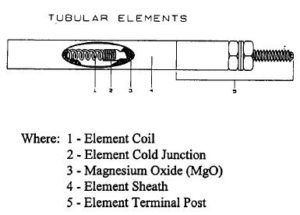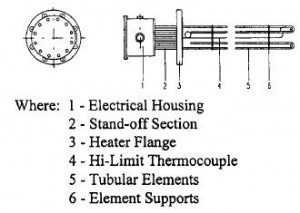Flange Heaters
Last updated on May 17th, 2025 at 05:08 am
Electric heating can involve any process which converts electrical energy into heat1. A perfect example is an electric flanged heater. It has various applications that include, water and oil heating, space heating, cooking and is popular in industrial processes2. An electric heater works on the principle of Joule heating3. This is a process where an electric current passes through a conductor which converts it into heat.
Tubular electric heater technology has been in practice from over 30 years. Recently its use in chemical and petrochemical industries has increased. Improvements in safety features, control schemes and product design have given this technology an advantage over other means of heat.
A basic tubular heating element consists of nickel-chromium (Ni-Cr) (80-20% or 70-30%) wire, which provides resistance to electricity generating heat6. Compact magnesium oxide (MgO) and a metal sheath surround the Ni-Cr wire (see figure below). Cold pins (metal conductors) make electrical connections to the resistance wire. Electric termination is available in various forms. Since MgO is very hydroscopic, so sealing is important to prevent moisture from entering.
These tubular elements are welded into a flange making an immersion heater assembly. Normally an immersion heater assembly consists of heating elements, flange or tube sheet, thermocouples and its housing and bussing for element circuit (see figure below). To heat a fluid or gas directly, this heater assembly can be bolted into the tank or can be mounted into a pressure vessel.
Flange Heater Performance
Detailed information about the application is required for most applications in the petrochemical industry to ensure the heaters’ successful performance. Some of the information required includes, medium to be heated, inlet and outlet temperature, operating pressure, flow rate or tank size, design temperature and pressure, area of use (i.e. indoor, outdoor), hazardous location (If yes, state Class, Group, & Division), allowable pressure drop, heat-up time, inlet and outlet pipe connection sizes, voltage available and accuracy of temperature control required.
Proper sheath and vessel material selection is important. Some of the factors for material selection include, design and sheath temperature, design pressure and corrosive nature of the target medium. The follow table is a good reference6.
Steel flanged immersion heaters are common for low flow gas heating. As well as heavy and light oils, lubricanting oils, mild sorrosive liquids and waxes. They are also used in deionized and demineralized water, detergent solutions, process water and soap. There are many advantages of using steel for the heater such as, minimizes heat loss, corrosion resistance, extended life etc.
Stainless steel flanged heating elements are more suited with mild to severe corrosive solutions. For sanitary purposes, they are also used in the food industry.
Fluid Preheating Alternatives for Oil & Gas
In recent years, there has been a depletion of gas reserves in the oil and gas industry. As well as a constant increase in demand and the rising cost of natural gas. This has created a need for an alternate source for preheating produced fluids in heater treaters in oil fields. Electric immersion heaters provide a safe, efficient, reliable and economical way to fulfill this need when compared to other conventional heating techniques7.
Another example for the application of electric heating in the petrochemical industry is to provide freeze protection and process maintenance on the piping systems9. Advantages in this particular application include minimum installation cost, lower operational cost, better control of heat.
Electric resistance heating is a substitute for conventional steam and direct-fired heating in the petroleum, petrochemical and chemical industries10. Comparative evaluation indicates electric heating to be more promising. This is due to the superior efficiency of electricity in comparison to other conventional forms of heating.
Another area for application of electric heaters is in aircraft propellers8. Formation of ice on the propellers is a potential hazard. This is due to the effects it can have on the balance, aerodynamic and structural characteristics of the propeller and the airplane. Electric heating provides a convenient means to obtain the necessary heating to prevent ice formation on propeller blades under adverse installation conditions.
Oil Sands Separation
Removing sand from crude oil is a very expensive process. And the high oil viscosity in many oil fields minimizes the efficiency of separation. To solve the problem of low efficiency with high viscosity oils, electric heating has a high application and is given more attention and importance by oil companies due to their application in oil fields solving the problem of low efficiency with high viscosity5.
It has a variety of applications in oil fields related to oil sands separation technology. Such as the separation of oil sands of aqueous air, cleaner ultrasonic degreasing of oil sands and application of micro-emulsion in oil sands lotion.
An example for its application is in heavy oil desanding of offshore platform5 where a special copper powder works as the conducting material for the electric heater. The powder goes between the tubing and the heating coils. This powder has high resistivity and the transient heating effect that helps to achieve the temperature requirements in a shorter period of time. Results include high thermal efficiency, ease of installation, low maintenance and stable and reliable performance.
Chemical Process Industries
Immersion heaters are widely used in a variety of applications in the chemical process industries4 (CPI). These heaters are used in fluids like, viscous materials, molten materials and gases, water, oils, solvents and process solutions. They come in different characteristic choices like:
- Size
- Termination connections
- Sheath materials
- Sheath accessories
- Kilowatt ratings (power)
- Voltages (electrical potential)
Due to the complete transmission of heat within the liquid of gas, immersion heaters are virtually 100% energy efficient.
Square-flange heaters are popular in applications such as storage tanks and industrial water boilers that hold fuel oils, caustic solutions, degreasing solvents and heat transfer fluids. Screw-plug heaters are common in applications like:
- Demineralized water
- Process water
- Caustic cleaners
- Antifreeze solutions (glycol)
- Industrial tanks
- Clean-water rinse tanks
- De-ionized water
- Liquid paraffin
- Hydraulic and crude oils
- Chemical baths
Through the side immersion heaters are generally used in high-pressure applications such as superheated and compressed gas tanks. But they also find use in non-pressurized tanks.
Heater Selection
Selecting the right heater based on the application required is very important and depends on the application’s characteristics and requirements. Usually, heat required for the job is determined, which is then converted to the required electrical power and accordingly a heater is selected. Determination of the power required is the same for heating liquids, solids or gases.
Properties of the target material also play an important role in the selection of a heater. For example, crude petroleum oil, which usually is thick and viscous, requires a very low-watt density. Whereas, vegetable oil which is very light, could only use up only 30-40 watt/in4. Watt density depends on thermal conductivity, viscosity and specific heat of the oil. Estimating proper watt density protects the heater against coking.
Coking is a deposit usually formed on the sheath of the heater due to chemical breakdown of the heated material. The amount of coking depends on the maximum operating temperature of the oil. It usually occurs in petroleum products, which causes the life of the heater to deteriorate and leads to early failure.
Flange Heater Design
Heater design can play a vital role in preventing or minimizing coking. For example, the sheath of a flat tubular element is cooler than that of a round tubular element when operated at the same watt density. And hence, the flat element has a lower risk for coking.
In the end, it can said that electric heater applications range from heating various liquids and gases to extremely high temperatures. For example, steam superheating, heat transfer fluids, fuel oils and corrosive solutions. Electric heating technology has progressed a long way in safety, design standards, reliability and controllability. There are no emission concerns, keeping the environment safe. The key to proper performance is good engineering practices and in-depth knowledge about the application to ensure to maximize design.
References
1. http://en.wikipedia.org/wiki/Electric_heating#cite_note-3
2. Donald G. Fink and H. Wayne Beaty, Standard Handbook for Electrical Engineers, Eleventh Edition,McGraw-Hill, New York, ISBN 0-07-020974-X, pages 21-144 to 21-188, 1978.
3. http://en.wikipedia.org/wiki/Joule_heating.
4. Robert Klein, Immersion heaters: selection & implementation, Chemical Engineering. 113.1, p. 44-48, Jan 2006.
5. Ding Feng, Nian Liu, Xiaofei Chang, Peng Wang, Chao Ruan and Hong Zhang, The application of electric heater in heavy oil desanding of offshore platform, IEEE, 2011.
6. Rob Bohn, Mike Bange and Joe Foreman, The basics of electric process heating, IEEE, Paper No. PCIC-94-14, 1994.
7. Palastak, James E, Use of electric immersion heating elements in oilfield heater-treaters, SPE Eastern Regional Meeting, Society of Petroleum Engineers, 4-6 November, Columbus, Ohio, 1981.
8. Jack H. Sheets, Edward J. Sand, Development and application of electric heating to deicing of aircraft propellers, IEEE, vol. 68, 1949.
9. C.J. Erickson, James D. Lyons, N.R. Rafferty, Chet Sandberg, A study of steam vs electrical pipeline heating costs on a typical petro-chemical plant project, IEEE, paper no. PCIC-90-02, 1990.
10. Anon, Steam substitution in chemical process, petrochemical and petroleum industries, research and development report, Canadian electrical association, issn: 08232660, March 1987.



